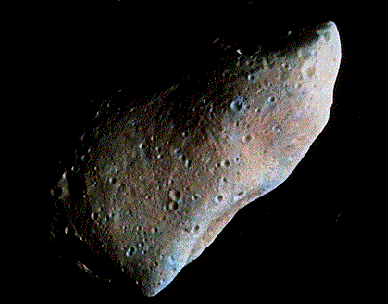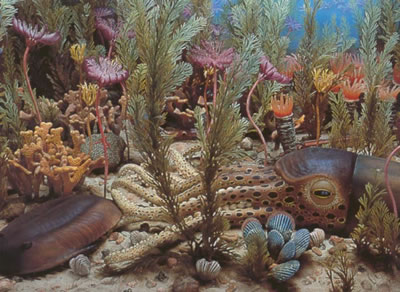Death of our planet
Asteroid
impacts and
supernovae.
Asteroids are rocky and metallic objects that orbit the Sun but are too small to be considered planets. An asteroid impact with the Earth is always on the cards. Asteroids have
hit Earth in the past, but unlike the Moon, evidence of such impacts
has been weathered away. A number of Earth's mass extinctions millions
of years ago are linked to such impacts. The most famous asteroid impacted
about 60 million years ago and caused the extinction of the dinosaurs.
Nothing bigger than a chicken could survive the altered environment
that resulted after the impact.

Asteroid Gaspra, as viewed from the Galileo spacecraft. Galileo, while
on its way to Jupiter, encountered Gaspra on October 29, 1991. Gaspra
is approximately 19 kilometres across.
Death of the dinosaurs but life on earth continues.
NASA scientists have predicted that a 10 km rock strikes earth every 100 million years. There are many asteroid orbiting around the sun potentially capable of crashing into Earth. However this does not mean that all life will become extinct.
Earth
is no stranger to catastrophic collisions with astronomical objects.
In fact, 65 million years ago an asteroid, 300 km wide, crashed through
our atmosphere and slammed into, what is now, the Gulf of Mexico. The
impact was so violent that it liquefied rock and sent earth quakes reverberating
around the planet. Giant tsunamis traveled at great speeds across the
oceans while huge clouds of dust and rock were blasted high into the
atmosphere blocking out sunlight.
Photosynthesis ceased as months of darkness followed. Many of the larger
animals simply perished as their food source dried up.
Smaller animals, such as mammals that were struggling to compete with
the dinosaurs now flourished.
Why did the large herbivores die first?
Why did the mammals thrive in conditions that wiped out there dinosaur rivals?

What is the Near Earth Object Program?
Why did NASA initiate this program?